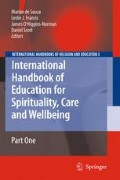Abstract
This chapter explores the meaning of Eros and its relationship to education. The Greek categories of Eros, Xenia, Philia, Storge, and Agape are used a framework for this discussion. Each form is examined and their possible meanings in an educational context.
Up until the modern age, Eros was seen as central to human life. The Greek poet, Hesiod, suggested that Eros was the most ancient of the Gods, and his function was to “coordinate the elements that constitute the universe.” Eros was the personification of the forces that bring harmony out of chaos in the universe. Later Eros was linked to human love through the myth of Eros and Psyche. Bringing Eros into our discussions of education can help move the dialogue away from its limited focus on accountability to broader and more inclusive vision.
Access this chapter
Tax calculation will be finalised at checkout
Purchases are for personal use only
Preview
Unable to display preview. Download preview PDF.
References
Baldwin, C. (1994). Calling the circle: The first and future culture. Newberg, Oregon : Swan Raven & Co.
Barker, R. B., & Gump, P. V. (1964). Big school, small school. Palo Alto, CA: Stanford University Press.
Chadwick, D. (1999). Crooked cucumber: The life and Zen teachings of Shunryu Suzuki. New York: Broadway Books.
Cotton, K. (1996). Close-up #20. School improvement research series. Portland, OR: Northwest Regional Educational Lab.
Gandhi, M. K. (Ed.). (1999). The way to God. Berkeley, CA: Berkeley Hills.
Gibbs, J. (1994). Tribes: A new way of learning together. Santa Rosa, CA: Center Source Publications.
Gougeon, L. (2007). Emerson & Eros: The making of a cultural hero. Albany, NY: State University of New York Press.
Hawken, P. (2007). Blessed unrest: How the largest movement in the world came into being and why no one saw it coming. New York: Viking.
Jones, H. W. (Ed.) (1966). Emerson on education: Selections. New York: Teachers College Press.
King, M. L. Jr. (1967). Where do we go from here: Chaos or community? New York: Harper & Row.
King, M. L. Jr. (1968). Honoring Dr. Du Bois. Freedomways, 8(2), 104–111.
King, M. L. Jr. (1968, May), The American dream, Negro History Bulletin. 31(5), 10–15.
Kozol, J. (2007). Letters to a young teacher. New York: Crown.
Lee, V., & Smith, J. (1994). Effects of high school restructuring on size and achievement. Madison, WI: National Center for Organization and Restructuring of Schools.
Lin, J. (2006). Love, peace, and wisdom in education: A vision for education in the 21st century. Latham, MD: Rowan & Littlefield Education.
Mandela, N. (1994). Long walk to freedom. Boson: Little, Brown.
Miller, Jack (1995). Meditating Teachers in Inquiring Mind. 12:19–22.
Miller, J. P. (2006). Educating for wisdom and compassion: Creating conditions for timeless learning. Thousand Oaks, CA: Corwin Press.
Paz, O. (1995). The double flame: Love and eroticism. New York: Harcourt.
Phillips, C. (2007). Socrates in love: Philosophy for a passionate heart. New York: W.W. Norton.
Ruiz, D. M. (2004). The voice of knowledge: A practical guide to inner peace. San Rafael, CA: Amber-Allen Publishing.
Sher, J.O. (1977). Education in rural America. Boulder, CO: Westview Press.
Smith, K. L., & Zepp, I. G. Jr. (1998). Search for the beloved community: The thinking for Martin Luther King Jr. Valley Forge: Judson.
Thomas, R. (2004, January 15) Lopez’s teaching is simply one of the purest expressions of love I’ve seen on film [Review of the film Être et Avoir] http://www.rottentomatoes.com/m/to_be_and_to_have/articles/1238605/
Wasley, P. (2000). Small schools and the issue of scale. New York: Bank Street College of Education.
Author information
Authors and Affiliations
Corresponding author
Editor information
Editors and Affiliations
Rights and permissions
Copyright information
© 2009 Springer Science+Business Media B.V.
About this chapter
Cite this chapter
Miller, J.P. (2009). Education and Eros. In: de Souza, M., Francis, L.J., O’Higgins-Norman, J., Scott, D. (eds) International Handbook of Education for Spirituality, Care and Wellbeing. International Handbooks of Religion and Education, vol 3. Springer, Dordrecht. https://doi.org/10.1007/978-1-4020-9018-9_31
Download citation
DOI: https://doi.org/10.1007/978-1-4020-9018-9_31
Publisher Name: Springer, Dordrecht
Print ISBN: 978-1-4020-9017-2
Online ISBN: 978-1-4020-9018-9
eBook Packages: Humanities, Social Sciences and LawEducation (R0)

